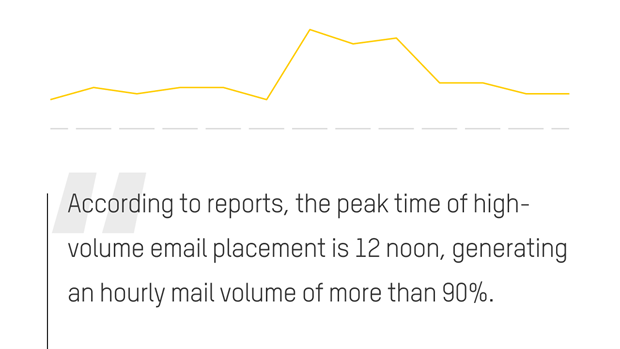Last year, businesses had to switch up their email marketing tactics to adapt to the evolving consumer landscape. Here are some of the trends that emerged from this massive disruption and how they changed the current state of play.
A Spike In Volume of Delivered Emails
At the height of the coronavirus scare, the volume of delivered emails ballooned to an all-time high. More than 55% of businesses bumped up the volume of their email campaigns to reach their audiences amid the health protocols and lockdown measures. From April 2020, Validity saw a significant increase of delivered emails, which was a massive leap from the preceding months, and maintained a steady rate throughout the year.
Across all industries, essential sectors were the first to increase the volume of their email campaigns. To keep the public informed and up to date, the health sector increased its campaign volume to 36%, while the government upped its email efforts to more than 26%. Nonprofit organizations, which were completely immobilized during the pandemic, also increased their email volume to an astounding 40% to stay afloat amid the global health crisis.
Alongside the surge in delivered campaigns, email open rates also experienced a sudden spike. Consumers showed more interest in email campaigns at the start of the global health crisis. In fact, Campaign Monitor reported a three-point to four-point percentage month over month increase from February to April last year. Meanwhile, open rates remained at a steady rate stepping into 2021.
Furthermore, reports revealed that emails with coronavirus-related content generated higher read rates compared to other forms of email campaigns. According to Validity, email users were 30% more likely to open campaigns related to the pandemic. These types of campaigns also recorded higher open rates on weekends when users typically have more time to comb through their inboxes.
A Shift In Email Topics
Since consumers have become more receptive to COVID-19-related content, companies have been writing more emails related to the pandemic to increase engagement and boost conversion. COVID-related emails skyrocketed specifically during March of 2020 at the onset of the health crisis.
Furthermore, marketers have been sending more emails with subject lines and messaging that feature keywords like “COVID,” “coronavirus,” “update,” and “important” to capture the attention of users as well as inspire a sense of urgency.
Businesses have also been playing on emotional appeals to encourage interaction and inspire action from their subscribers. Keywords such as “community,” “love,” “together,” “help,” and “safe” are being widely used to draw in more users. There are also other keywords that are being utilized more often during this pandemic, namely, “need,” “free,” “life,” “guide,” and “reminder.”
However, businesses should be strategic when it comes to sending pandemic-related messages. At this point, oversaturation of this type of messaging can fatigue audiences. Marketers must make sure that emails related to this topic include new information or fresh campaigns that appeal to more users.
A Change in Campaign Schedules
Aside from changing email campaign topics, marketers have pushed back their campaign schedules, sending them out in the afternoon instead. Before the pandemic, mornings were seen as the most ideal time to launch email campaigns because of the high deliverability and open rates.
However, because of the global shift to remote setup, people’s work schedules and activities, including checking their inboxes, also changed. People now have more time to look through their inboxes past lunchtime and afternoon breaks. That’s why marketers saw an increase in placement and engagement rates in emails sent later in the day.
Because of this, many marketers are now religiously sending out their campaigns somewhere around noon to 5 in the afternoon. According to reports, the peak time of high-volume email placement is noon, generating an hourly mail volume of more than 90%. It can also be noted that most businesses refrain from forwarding campaigns at around 6 in the evening, as it boasts an hourly mail volume of just less than 85%.

A Surge in Phishing Attacks
Many saw this boom in email as an opportunity to take advantage of unsuspecting users. Since the start of the pandemic, phishing and fraud cases in the inbox have increased. In March 2020 alone, phishing activities swelled to 220%. Experts predict that these numbers will continue to increase by up to 15% until 2021. Because of the growing risks, more and more users are becoming cautious when it comes to the emails they receive. But aside from suspicious emails, users are also keeping an eye on junk emails.
With the increased volume of delivered emails, consumers are becoming less tolerant of spammy messages. So it’s no surprise that complaints have also increased during the pandemic. In particular, the months of September 2020 to December 2020 experienced a spike in complaints as marketers bombarded users with year-end campaigns during the holidays.
However, for pandemic-related emails, consumers tend to be more lenient. These types of campaigns are 11% less likely to be reported as spam by consumers. This just shows that relevance is still an important factor for users to reduce bounce rates, unsubscriptions, and reports when it comes to email.



